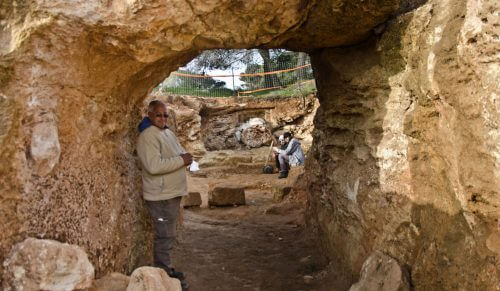The highlight of the excavation is a magnificent tomb complex, which included a vestibule that led to a large courtyard carved into the rock and surrounded by a bench. An opening to the burial cave was cut in the front. As was customary in Jewish burial caves in the days of the Second Temple, this cave consisted of several rooms, and elongated burial chambers were cut into its walls in which the bodies of the deceased were placed. After the cave was documented by the archaeologists, it was sealed at the request of rabbinical authorities, to prevent future desecration of the tomb

Impressive remains of a rural Jewish settlement from the Hasmonean era - about 2000 years ago - have been revealed in recent months in archaeological excavations by the Antiquities Authority in preparation for the establishment of an urban school in the Sharfat neighborhood in southern Jerusalem, financed by the Moriah company, and for the Jerusalem municipality.
A large wine cellar with many fragments of jugs, a large columbarium cave (dove trap), a textile mill for oil production, a large purification mikvah (which joins another mikvah previously identified at the site) were discovered on the site. Burmese and caves. At a later stage, the buildings in the settlement were destroyed, and their stones were taken from the site for reuse.
The highlight of the excavation is a magnificent tomb complex, which included a vestibule that led to a large courtyard carved into the rock and surrounded by a bench. An opening to the burial cave was cut in the front. As was customary in Jewish burial caves in the days of the Second Temple, this cave consisted of several rooms, and elongated burial chambers were cut into its walls in which the bodies of the deceased were placed. After the cave was documented by the archaeologists, it was sealed at the request of rabbinical authorities, to prevent future desecration of the tomb.
According to Jacob Bilig, the director of the excavation on behalf of the Antiquities Authority, "It seems that wealthy or important family members were buried here during the Hasmonean period. The grave estate was used for the burial of family members for several generations, as was customary at that time."
In the dirt filling that covered the cave courtyard, large building stones were found, some designed and decorated in the best architectural style of the Second Temple period, when the building styles were divided into architectural orders. The most special of the items is a heart-shaped page header from the Doric order, and in addition, several designed cornices were also found. These stone items are very rare, and they were usually incorporated into magnificent buildings and the magnificent burial estates of Jerusalem, such as that of the priestly family Bnei Hamz in Kidron, and in a number of tombs in the Sanhedria neighborhood of Jerusalem.
The current excavation area is, apparently, only a small part of an ancient settlement that extended to the south of the area. The excavation reveals a rural agricultural area, where they engaged, among other things, in the production of wine and oil, and in raising pigeons. The breeding of the pigeons is done in a "columbarium", a special facility like which several dozen were also found around Jerusalem; In the days of the Second Temple and other periods, pigeon breeding was a major agricultural branch for several reasons: the pigeons themselves as well as the eggs were used for food, and it is known that they were brought as a sacrifice to the temple. In addition, the pigeon manure was used as a valuable fertilizer, since it is rich in minerals and decomposes quickly in the soil, and it allowed the fruit orchards and vegetable gardens to flourish.
